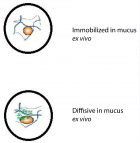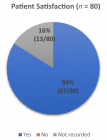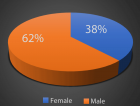Abstract
Short Review
Evaluation of In vitro and Ex vivo Models for Studying the Effectiveness of Vaginal Drug Systems in Controlling Microbe Infections: A Systematic Review
Mohammad Hossein Karami*, Majid Abdouss* and Mandana Karami
Published: 28 November, 2023 | Volume 6 - Issue 4 | Pages: 201-215
The survey gives an in-depth examination of medicate assimilation challenges within the genital range and the improvement of vaginal medicate conveyance gadgets to overcome these challenges. It investigates the components involved in medicate discharge within the genital locale and examines commonly utilized vaginal sedate conveyance frameworks such as nanoparticles and hydrogels. The survey centers on the applications of these conveyance frameworks in controlling bacterial vaginal diseases. The plan issues related to vaginal sedate conveyance gadgets are moreover examined, highlighting the significance of considering variables such as mucoadhesion and bodily fluid porousness. The survey portrays different in vitro and ex vivo models utilized for assessing these frameworks, counting organoids and new human cervical bodily fluid. The choice of show depends on the particular objectives and characteristics of the definition. The audit emphasizes the noteworthiness of utilizing these models to pick up important bits of knowledge and make precise forecasts with respect to the execution of medicate conveyance frameworks in vivo. Moreover, grandstands progressed models utilized for other mucosal locales as a potential motivation for future models of the female regenerative framework. Generally, the audit highlights the significance of understanding organic instruments and planning compelling vaginal drug conveyance frameworks to progress sedate conveyance within the genital region. It emphasizes the require for suitable models to evaluate and anticipate the execution of these conveyance frameworks.
Read Full Article HTML DOI: 10.29328/journal.cjog.1001151 Cite this Article Read Full Article PDF
Keywords:
Vaginal Drug Delivery Systems (VDDSs); Infections caused by microbes; Physiological barriers; In Vitro and Ex vivo models; Polymer gels
References
- Antaris AL, Chen H, Cheng K, Sun Y, Hong G, Qu C, Diao S, Deng Z, Hu X, Zhang B, Zhang X, Yaghi OK, Alamparambil ZR, Hong X, Cheng Z, Dai H. A small-molecule dye for NIR-II imaging. Nat Mater. 2016 Feb;15(2):235-42. doi: 10.1038/nmat4476. Epub 2015 Nov 23. PMID: 26595119.
- Lee JS, Youn YH, Kwon IK, Ko NR. Recent advances in quantum dots for biomedical applications. Journal of Pharmaceutical Investigation. 2018; 48(2): 209-214.
- Biswas MC, Islam MT, Nandy PK, Hossain MM. Graphene quantum dots (GQDs) for bioimaging and drug delivery applications: A review. ACS Materials Letters. 2021; 3(6): 889-911.
- Vedhanayagam M, Raja IS, Molkenova A, Atabaev TS, Sreeram KJ, Han DW. Carbon Dots-Mediated Fluorescent Scaffolds: Recent Trends in Image-Guided Tissue Engineering Applications. Int J Mol Sci. 2021 May 20;22(10):5378. doi: 10.3390/ijms22105378. PMID: 34065357; PMCID: PMC8190637.
- Facure MHM, Schneider R, Mercante LA, Correa DS. A review on graphene quantum dots and their nanocomposites: from laboratory synthesis towards agricultural and environmental applications. Environmental Science Nano. 2020; 7(12): 3710-3734.
- Chen W, Lv G, Hu W, Li D, Chen S, Dai Z. Synthesis and applications of graphene quantum dots: a review. Nanotechnology Reviews. 2018; 7(2): 157-185.
- Chen F, Gao W, Qiu X, Zhang H, Liu L, Liao P, Fu W, Luo Y. Graphene quantum dots in biomedical applications: Recent advances and future challenges. Frontiers in Laboratory Medicine. 2017; 1(4): 192-199.
- Nurunnabi M, Khatun Z, Huh KM, Park SY, Lee DY, Cho KJ, Lee YK. In vivo biodistribution and toxicology of carboxylated graphene quantum dots. ACS Nano. 2013 Aug 27;7(8):6858-67. doi: 10.1021/nn402043c. Epub 2013 Jul 9. PMID: 23829293.
- Qiu J, Zhang R, Li J, Sang Y, Tang W, Rivera Gil P, Liu H. Fluorescent graphene quantum dots as traceable, pH-sensitive drug delivery systems. Int J Nanomedicine. 2015 Oct 28;10:6709-24. doi: 10.2147/IJN.S91864. PMID: 26604747; PMCID: PMC4630193.
- Raja IS, Molkenova A, Kang MS, Lee SH, Lee JE, Kim B, Han DW, Atabaev TS. Differential Toxicity of Graphene Family Nanomaterials Concerning Morphology. Adv Exp Med Biol. 2022;1351:23-39. doi: 10.1007/978-981-16-4923-3_2. PMID: 35175610.
- Tabish TA, Scotton CJ, Ferguson DCJ, Lin L, der Veen AV, Lowry S, Ali M, Jabeen F, Ali M, Winyard PG, Zhang S. Biocompatibility and toxicity of graphene quantum dots for potential application in photodynamic therapy. Nanomedicine (Lond). 2018 Aug 1;13(15):1923-1937. doi: 10.2217/nnm-2018-0018. Epub 2018 Aug 20. PMID: 30124363.
- Li P, Xu T, Wu S, Lei L, He D. Chronic exposure to graphene-based nanomaterials induces behavioral deficits and neural damage in Caenorhabditis elegans. J Appl Toxicol. 2017 Oct;37(10):1140-1150. doi: 10.1002/jat.3468. Epub 2017 Apr 18. PMID: 28418071.
- Nigam P , Waghmode S , Louis M , Wangnoo S , Chavan P , Sarkar D . Graphene quantum dots conjugated albumin nanoparticles for targeted drug delivery and imaging of pancreatic cancer. J Mater Chem B. 2014 Jun 7;2(21):3190-3195. doi: 10.1039/c4tb00015c. Epub 2014 Apr 28. PMID: 32261580.
- Wang S, Cole IS, Li Q. The toxicity of graphene quantum dots. RSC Advances. 2016; 6(92): 89867-89878.
- Tajik S, Dourandish Z, Zhang K, Beitollahi H, Le QV, Jang HW, Shokouhimehr M. Carbon and graphene quantum dots: a review on syntheses, characterization, biological and sensing applications for neurotransmitter determination. RSC Adv. 2020 Apr 20;10(26):15406-15429. doi: 10.1039/d0ra00799d. PMID: 35495425; PMCID: PMC9052380.
- Henna TK, Pramod K. Graphene quantum dots redefine nanobiomedicine. Mater Sci Eng C Mater Biol Appl. 2020 May;110:110651. doi: 10.1016/j.msec.2020.110651. Epub 2020 Jan 8. PMID: 32204078.
- Masteri-Farahani M, Ghorbani F, Mosleh N. Boric acid modified S and N co-doped graphene quantum dots as simple and inexpensive turn-on fluorescent nanosensor for quantification of glucose. Spectrochim Acta A Mol Biomol Spectrosc. 2021 Jan 15;245:118892. doi: 10.1016/j.saa.2020.118892. Epub 2020 Aug 28. PMID: 32916423.
- Li L, Li L, Wang C, Liu K. Synthesis of nitrogen-doped and amino acid-functionalized graphene quantum dots from glycine, and their application to the fluorometric determination of ferric ion. Microchimica Acta. 2015; 182: 763-770.
- Xue G, Yu S, Qiang Z, Xiuying L, Tang Lijun, Jiangrong L. Application of maleimide modified graphene quantum dots and porphyrin fluorescence resonance energy transfer in the design of ''turn-on'' fluorescence sensors for biothiols. Anal Chim Acta. 2020 Apr 29;1108:46-53. doi: 10.1016/j.aca.2020.01.062. Epub 2020 Jan 29. PMID: 32222243.
- Yu D, Zhang X, Qi Y, Ding S, Cao S, Zhu A, Shi G. Pb2+-modified graphene quantum dots as a fluorescent probe for biological aminothiols mediated by an inner filter effect. Sensors and Actuators B: Chemical. 2016; 235: 394-400.
- Zhu Q, Mao H, Li J, Hua J, Wang J, Yang R, Li Z. A glycine-functionalized graphene quantum dots synthesized by a facile post-modification strategy for a sensitive and selective fluorescence sensor of mercury ions. Spectrochim Acta A Mol Biomol Spectrosc. 2021 Feb 15;247:119090. doi: 10.1016/j.saa.2020.119090. Epub 2020 Oct 17. PMID: 33137626.
- Zhang P , Zhao X , Ji Y , Ouyang Z , Wen X , Li J , Su Z , Wei G . Electrospinning graphene quantum dots into a nanofibrous membrane for dual-purpose fluorescent and electrochemical biosensors. J Mater Chem B. 2015 Mar 28;3(12):2487-2496. doi: 10.1039/c4tb02092h. Epub 2015 Feb 18. PMID: 32262123.
- Safaei-Ghomi J, Elyasi Z, Babaei P. N-doped graphene quantum dots modified with CuO (0D)/ZnO (1D) heterojunction as a new nanocatalyst for environmental being one-pot synthesis of monospiro derivatives. New Journal of Chemistry. 2021; 45(3): 1269-1277.
- Xu T, Wang D, Dong L, Shen H, Lu W, Chen W. Graphitic carbon nitride comodified by zinc phthalocyanine and graphene quantum dots for the efficient photocatalytic degradation of refractory contaminants. Applied Catalysis B: Environmental. 2019; 244: 96-106.
- Yu Z, Ma W, Wu T, Wen J, Zhang Y, Wang L, He Y, Chu H, Hu M. Coumarin-Modified Graphene Quantum Dots as a Sensing Platform for Multicomponent Detection and Its Applications in Fruits and Living Cells. ACS Omega. 2020 Mar 25;5(13):7369-7378. doi: 10.1021/acsomega.9b04387. PMID: 32280878; PMCID: PMC7144171.
- Yang S, Zhu C, Sun J, He P, Yuan N, Ding J, Ding G. Triphenylphosphine modified graphene quantum dots: spectral modulation for full spectrum of visible light with high quantum yield. RSC Advances. 2015; 5(42): 33347-33350.
- Guo R, Zhou S, Li Y, Li X, Fan L, Voelcker NH. Rhodamine-Functionalized Graphene Quantum Dots for Detection of Fe(3+) in Cancer Stem Cells. ACS Appl Mater Interfaces. 2015 Nov 4;7(43):23958-66. doi: 10.1021/acsami.5b06523. Epub 2015 Oct 26. PMID: 26317667.
- Song H, Wang Y, Wang J, Wang G, He J, Wei H, Luo S. Preparation and biodistribution of 131I-labeled graphene quantum dots. Journal of Radioanalytical and Nuclear Chemistry. 2018; 316:685-690.
- Gharepapagh E, Fakhari A, Firuzyar T, Shomali A, Azimi F. Preparation, biodistribution and dosimetry study of Tc-99m labeled N-doped graphene quantum dot nanoparticles as a multimodular radiolabeling agent. New Journal of Chemistry. 2021; 45(8): 3909-3919.
- Chong Y, Ma Y, Shen H, Tu X, Zhou X, Xu J, Dai J, Fan S, Zhang Z. The in vitro and in vivo toxicity of graphene quantum dots. Biomaterials. 2014 Jun;35(19):5041-8. doi: 10.1016/j.biomaterials.2014.03.021. Epub 2014 Mar 28. PMID: 24685264.
- Kim DJ, Yoo JM, Suh Y, Kim D, Kang I, Moon J, Park M, Kim J, Kang KS, Hong BH. Graphene Quantum Dots from Carbonized Coffee Bean Wastes for Biomedical Applications. Nanomaterials (Basel). 2021 May 28;11(6):1423. doi: 10.3390/nano11061423. PMID: 34071339; PMCID: PMC8228242.
- Tang H, Li Y, Kakinen A, Andrikopoulos N, Sun Y, Kwak E, Davis TP, Ding F, Ke PC. Graphene quantum dots obstruct the membrane axis of Alzheimer's amyloid beta. PCCP. 2022; 24(1): 86-97.
- Rostamzadeh F, Shadkam-Farrokhi M, Jafarinejad-Farsangi S, Najafipour H, Ansari-Asl Z, Yeganeh-Hajahmadi M. PEGylated Graphene Quantum Dot Improved Cardiac Function in Rats with Myocardial Infarction: Morphological, Oxidative Stress, and Toxicological Evidences. Oxid Med Cell Longev. 2021 Nov 20;2021:8569225. doi: 10.1155/2021/8569225. PMID: 34845418; PMCID: PMC8627339.
- Abdullah-Al-Nahain, Lee JE, In I, Lee H, Lee KD, Jeong JH, Park SY. Target delivery and cell imaging using hyaluronic acid-functionalized graphene quantum dots. Mol Pharm. 2013 Oct 7;10(10):3736-44. doi: 10.1021/mp400219u. Epub 2013 Sep 19. PMID: 24007260.
- Jia Q, Li Z, Guo C, Huang X, Song Y, Zhou N, Wang M, Zhang Z, He L, Du M. A γ-cyclodextrin-based metal-organic framework embedded with graphene quantum dots and modified with PEGMA via SI-ATRP for anticancer drug delivery and therapy. Nanoscale. 2019 Nov 21;11(43):20956-20967. doi: 10.1039/c9nr06195a. Epub 2019 Oct 29. PMID: 31660562.
- Wei Z, Yin X, Cai Y, Xu W, Song C, Wang Y, Zhang J, Kang A, Wang Z, Han W. Antitumor effect of a Pt-loaded nanocomposite based on graphene quantum dots combats hypoxia-induced chemoresistance of oral squamous cell carcinoma. Int J Nanomedicine. 2018 Mar 13;13:1505-1524. doi: 10.2147/IJN.S156984. PMID: 29559779; PMCID: PMC5856292.
- Nafiujjaman M, Revuri V, Park HK, Kwon IK, Cho KJ, Lee YK. Enhanced Photodynamic Properties of Graphene Quantum dot Conjugated Ce6 Nanoparticles for Targeted Cancer Therapy and Imaging. Chemistry Letters. 2016; 45(8): 997-999.
- Wang C, Chen Y, Xu Z, Chen B, Zhang Y, Yi X, Li J. Fabrication and characterization of novel cRGD modified graphene quantum dots for chemophotothermal combination therapy. Sens. Actuators B: Chem. 2020; 309: 127732.
- Cao Y, Dong H, Yang Z, Zhong X, Chen Y, Dai W, Zhang X. Aptamer-Conjugated Graphene Quantum Dots/Porphyrin Derivative Theranostic Agent for Intracellular Cancer-Related MicroRNA Detection and Fluorescence-Guided Photothermal/Photodynamic Synergetic Therapy. ACS Appl Mater Interfaces. 2017 Jan 11;9(1):159-166. doi: 10.1021/acsami.6b13150. Epub 2016 Dec 22. PMID: 27957830.
- Yang S, Wang X, He P, Xu A, Wang G, Duan J, Shi Y, Ding G. Graphene Quantum Dots with Pyrrole N and Pyridine N: Superior Reactive Oxygen Species Generation Efficiency for Metal-Free Sonodynamic Tumor Therapy. Small. 2021 Mar;17(10):e2004867. doi: 10.1002/smll.202004867. Epub 2021 Jan 28. PMID: 33511794.
- Yan H, Wang Q, Wang J, Shang W, Xiong Z, Zhao L, Sun X, Tian J, Kang F, Yun SH. Planted Graphene Quantum Dots for Targeted, Enhanced Tumor Imaging and Long-Term Visualization of Local Pharmacokinetics. Adv Mater. 2023 Apr;35(15):e2210809. doi: 10.1002/adma.202210809. Epub 2023 Mar 3. PMID: 36740642; PMCID: PMC10374285.
- Qi L, Pan T, Ou L, Ye Z, Yu C, Bao B, Wu Z, Cao D, Dai L. Biocompatible nucleus-targeted graphene quantum dots for selective killing of cancer cells via DNA damage. Commun Biol. 2021 Feb 16;4(1):214. doi: 10.1038/s42003-021-01713-1. PMID: 33594275; PMCID: PMC7886873.
- Kuo WS, Shao YT, Huang KS, Chou TM, Yang CH. Antimicrobial Amino-Functionalized Nitrogen-Doped Graphene Quantum Dots for Eliminating Multidrug-Resistant Species in Dual-Modality Photodynamic Therapy and Bioimaging under Two-Photon Excitation. ACS Appl Mater Interfaces. 2018 May 2;10(17):14438-14446. doi: 10.1021/acsami.8b01429. Epub 2018 Apr 19. PMID: 29620851.
- Zubair M, Husain FM, Fatima F, Oves M, Ansari MA, Almari M, Dai L. (Eds.). Graphene quantum dots biomedical and environmental sustainability applications. Woodhead Publishing. 2023; 83-100.
- Kortel M, Mansuriya BD, Vargas Santana N, Altintas Z. Graphene Quantum Dots as Flourishing Nanomaterials for Bio-Imaging, Therapy Development, and Micro-Supercapacitors. Micromachines (Basel). 2020 Sep 18;11(9):866. doi: 10.3390/mi11090866. PMID: 32962061; PMCID: PMC7570118.
- Wang C, Wu C, Zhou X, Han T, Xin X, Wu J, Zhang J, Guo S. Enhancing cell nucleus accumulation and DNA cleavage activity of anti-cancer drug via graphene quantum dots. Sci Rep. 2013 Oct 4;3:2852. doi: 10.1038/srep02852. PMID: 24092333; PMCID: PMC3790198.
- González-Gaitán M, Stenmark H. Endocytosis and signaling: a relationship under development. Cell. 2003 Nov 26;115(5):513-21. doi: 10.1016/s0092-8674(03)00932-2. PMID: 14651844.
- Kaksonen M, Roux A. Mechanisms of clathrin-mediated endocytosis. Nat Rev Mol Cell Biol. 2018 May;19(5):313-326. doi: 10.1038/nrm.2017.132. Epub 2018 Feb 7. PMID: 29410531.
- Hillaireau H, Couvreur P. Nanocarriers' entry into the cell: relevance to drug delivery. Cell Mol Life Sci. 2009 Sep;66(17):2873-96. doi: 10.1007/s00018-009-0053-z. Epub 2009 Jun 5. PMID: 19499185.
- Nichols B. Caveosomes and endocytosis of lipid rafts. J Cell Sci. 2003 Dec 1;116(Pt 23):4707-14. doi: 10.1242/jcs.00840. PMID: 14600257.
- Sun YP, Zhou B, Lin Y, Wang W, Fernando KA, Pathak P, Meziani MJ, Harruff BA, Wang X, Wang H, Luo PG, Yang H, Kose ME, Chen B, Veca LM, Xie SY. Quantum-sized carbon dots for bright and colorful photoluminescence. J Am Chem Soc. 2006 Jun 21;128(24):7756-7. doi: 10.1021/ja062677d. PMID: 16771487.
- Gonçalves H, Esteves da Silva JC. Fluorescent carbon dots capped with PEG200 and mercaptosuccinic acid. J Fluoresc. 2010 Sep;20(5):1023-8. doi: 10.1007/s10895-010-0652-y. Epub 2010 Mar 30. PMID: 20352303.
- Chandra A, Deshpande S, Shinde DB, Pillai VK, Singh N. Mitigating the Cytotoxicity of Graphene Quantum Dots and Enhancing Their Applications in Bioimaging and Drug Delivery. ACS Macro Lett. 2014 Oct 21;3(10):1064-1068. doi: 10.1021/mz500479k. Epub 2014 Oct 6. PMID: 35610793.
- Chong Y, Ma Y, Shen H, Tu X, Zhou X, Xu J, Dai J, Fan S, Zhang Z. The in vitro and in vivo toxicity of graphene quantum dots. Biomaterials. 2014 Jun;35(19):5041-8. doi: 10.1016/j.biomaterials.2014.03.021. Epub 2014 Mar 28. PMID: 24685264.
- Sachdev A, Matai I, Gopinath P. Implications of surface passivation on physicochemical and bioimaging properties of carbon dots. RSC Advances. 2014; 4(62): 20915–20921.
- Gao T, Wang X, Yang LY, He H, Ba XX, Zhao J, Jiang FL, Liu Y. Red, Yellow, and Blue Luminescence by Graphene Quantum Dots: Syntheses, Mechanism, and Cellular Imaging. ACS Appl Mater Interfaces. 2017 Jul 26;9(29):24846-24856. doi: 10.1021/acsami.7b05569. Epub 2017 Jul 12. PMID: 28675929.
- Havrdová M, Hola K, Skopalik J, Tomankova K, Petr M, Cepe K, Polakova K, Tucek J, Bourlinos AB, Zboril R. Toxicity of carbon dots–Effect of surface functionalization on the cell viability, reactive oxygen species generation and cell cycle. Carbon. 2016; 99: 238-248.
- Ngafwan N, Rasyid H, Abood ES, Abdelbasset WK, Al-Shawi SG, Bokov D, Jalil AT Study on novel fluorescent carbon nanomaterials in food analysis. Food Science and Technology. 2021; 42(1).
- Xu H, Zhou S, Xiao L, Wang H, Li S, Yuan Q. Fabrication of a nitrogen-doped graphene quantum dot from MOF-derived porous carbon and its application for highly selective fluorescence detection of Fe 3+. Journal of Materials Chemistry C. 2015; 3(1): 291–297.
- Yang JM, Hu XW, Liu YX, Zhang W. Fabrication of a carbon quantum dots-immobilized zirconium-based metal-organic framework composite fluorescence sensor for highly sensitive detection of 4-nitrophenol. Microporous and Mesoporous Materials. 2019; 274: 149-154.
- Wei X, Wang Y, Huang Y, Fan C. Composite ZIF-8 with CQDs for boosting visible-light-driven photocatalytic removal of NO. Journal of Alloys and Compounds. 2019; 802: 467-476.
- Wang XM, Geng ZM, Sun H, Cong HL, Yu B. Preparation of C-ZIF-8 composite nanoparticles. Integrated Ferroelectrics. 2018; 188(1): 130-135.
- Camlik G, Ozakca I, Bilakaya B, Ozcelikay AT, Velaro AJ, Wasnik S, Degim IT. Development of composite carbon quantum dots-insulin formulation for oral administration. Journal of Drug Delivery Science and Technology. 2022; 76: 103833.
- Su M, Liu H, Ge L, Wang Y, Ge S, Yu J, Yan M. Aptamer-Based electrochemiluminescent detection of MCF-7 cancer cells based on carbon quantum dots coated mesoporous silica nanoparticles. Electrochimica Acta. 2014; 146: 262-269.
- Nozaki T , Kakuda T , Pottathara YB , Kawasaki H . A nanocomposite of N-doped carbon dots with gold nanoparticles for visible light active photosensitisers. Photochem Photobiol Sci. 2019 May 15;18(5):1235-1241. doi: 10.1039/c9pp00035f. PMID: 30843904.
- Ghosh Chaudhuri R, Paria S. Core/shell nanoparticles: classes, properties, synthesis mechanisms, characterization, and applications. Chem Rev. 2012 Apr 11;112(4):2373-433. doi: 10.1021/cr100449n. Epub 2011 Dec 28. PMID: 22204603.
- Alijani HQ, Fathi A, Amin HIM, Nobre MAL, Akbarizadeh MR, Khatami M, Jalil AT, Naderifar M, Dehkordi FS, Shafiee A. Biosynthesis of core–shell α-Fe2O3@ Au nanotruffles and their biomedical applications. Biomass Conversion and Biorefinery. 2022; 1-15.
- Eskalen H, Urus S, C ̈omertpay S, Kurt AH, Ozgan S. Microwave-assisted ultrafast synthesis of carbon quantum dots from linter: Fluorescence cancer imaging and human cell growth inhibition properties. Industrial Crops and Products. 2020; 147: 112209.
- Kong RM, Yang A, Wang Q, Wang Y, Ma L, Qu F. Uricase based fluorometric determination of uric acid based on the use of graphene quantum dot@ silver core-shell nanocomposites. Microchemical Journal. 2018; 185-186: 1-8.
- Pei H, Zhu S, Yang M, Kong R, Zheng Y, Qu F. Graphene oxide quantum dots@silver core-shell nanocrystals as turn-on fluorescent nanoprobe for ultrasensitive detection of prostate specific antigen. Biosens Bioelectron. 2015 Dec 15;74:909-14. doi: 10.1016/j.bios.2015.07.056. Epub 2015 Jul 29. PMID: 26257182.
- Liu Q, Guo B, Rao Z, Zhang B, Gong JR. Strong two-photon-induced fluorescence from photostable, biocompatible nitrogen-doped graphene quantum dots for cellular and deep-tissue imaging. Nano Lett. 2013 Jun 12;13(6):2436-41. doi: 10.1021/nl400368v. Epub 2013 May 15. PMID: 23675758.
- Zhang J, Yu SH. Carbon dots: large-scale synthesis, sensing and bioimaging. Materials Today. 2016; 19(6): 382-393.
- Wang B, Waterhouse GI, Qu X, Yang B, Lu S. Carbon Dots in Bioimaging, Biosensing and Therapeutics: A Comprehensive Review. Small Science. 2022; 2200012.
- Li LP, Ren XF, Bai PR, Liu Y, Xu WY, Xie J. Near-infrared emission carbon dots for bio-imaging applications. New Carbon Materials. 2021; 36(6): 632-638.
- Du J, Xu N, Fan J, Sun W, Peng X. Carbon Dots for In Vivo Bioimaging and Theranostics. Small. 2019 Aug;15(32):e1805087. doi: 10.1002/smll.201805087. Epub 2019 Feb 18. PMID: 30779301.
- Zhou N, Hao Z, Zhao X, Maharjan S, Zhu S, Song Y, Yang B, Lu L. A novel fluorescent retrograde neural tracer: cholera toxin B conjugated carbon dots. Nanoscale. 2015 Oct 14;7(38):15635-42. doi: 10.1039/c5nr04361a. Epub 2015 Aug 18. PMID: 26285001.
- Yuan F, Ding L, Li Y, Li X, Fan L, Zhou S, Fang D, Yang S. Multicolor fluorescent graphene quantum dots colorimetrically responsive to all-pH and a wide temperature range. Nanoscale. 2015 Jul 21;7(27):11727-33. doi: 10.1039/c5nr02007g. Epub 2015 Jun 23. PMID: 26102292.
- Fan Z, Li Y, Li X, Fan L, Zhou S, Fang D, Yang S. Surrounding media sensitive photoluminescence of boron-doped graphene quantum dots for highly fluorescent dyed crystals, chemical sensing and bioimaging. Carbon. 2014; 70: 149-156.
- Wang N, Zheng AQ, Liu X, Chen JJ, Yang T, Chen ML, Wang JH. Deep Eutectic Solvent-Assisted Preparation of Nitrogen/Chloride-Doped Carbon Dots for Intracellular Biological Sensing and Live Cell Imaging. ACS Appl Mater Interfaces. 2018 Mar 7;10(9):7901-7909. doi: 10.1021/acsami.8b00947. Epub 2018 Feb 21. PMID: 29424521.
- Sadhanala HK, Nanda KK. Boron-doped carbon nanoparticles: Sizeindependent color tunability from red to blue and bioimaging applications. Carbon. 2016; 96: 166-173.
- Ruan S, Qian J, Shen S, Chen J, Zhu J, Jiang X, He Q, Yang W, Gao H. Fluorescent carbonaceous nanodots for noninvasive glioma imaging after angiopep-2 decoration. Bioconjug Chem. 2014 Dec 17;25(12):2252-9. doi: 10.1021/bc500474p. Epub 2014 Nov 11. PMID: 25387274.
- Li H, Yan X, Qiao S, Lu G, Su X. Yellow-Emissive Carbon Dot-Based Optical Sensing Platforms: Cell Imaging and Analytical Applications for Biocatalytic Reactions. ACS Appl Mater Interfaces. 2018 Mar 7;10(9):7737-7744. doi: 10.1021/acsami.7b17619. Epub 2018 Feb 22. PMID: 29441784.
- Xue M , Zhao J , Zhan Z , Zhao S , Lan C , Ye F , Liang H . Dual functionalized natural biomass carbon dots from lychee exocarp for cancer cell targetable near-infrared fluorescence imaging and photodynamic therapy. Nanoscale. 2018 Oct 4;10(38):18124-18130. doi: 10.1039/c8nr05017a. PMID: 30255925.
- Sharma V , Tiwari P , Mobin SM . Sustainable carbon-dots: recent advances in green carbon dots for sensing and bioimaging. J Mater Chem B. 2017 Dec 7;5(45):8904-8924. doi: 10.1039/c7tb02484c. Epub 2017 Nov 6. PMID: 32264117.
- Jana P, Dev A. Carbon Quantum Dots: A Promising Nanocarrier for Bioimaging and Drug Delivery in Cancer. Materials Today Communications. 2022; 25: 104068.
- Azizi M, Valizadeh H, Shahgolzari M, Talebi M, Baybordi E, Dadpour MR, Salehi R, Mehrmohammadi M. Synthesis of Self-Targeted Carbon Dot with Ultrahigh Quantum Yield for Detection and Therapy of Cancer. ACS Omega. 2020 Sep 17;5(38):24628-24638. doi: 10.1021/acsomega.0c03215. PMID: 33015480; PMCID: PMC7528278.
- Majood M, Garg P, Chaurasia R, Agarwal A, Mohanty S, Mukherjee M. Carbon Quantum Dots for Stem Cell Imaging and Deciding the Fate of Stem Cell Differentiation. ACS Omega. 2022 Aug 11;7(33):28685-28693. doi: 10.1021/acsomega.2c03285. PMID: 36033677; PMCID: PMC9404166.
- Hamd-Ghadareh S, Salimi A, Fathi F, Bahrami S. An amplified comparative fluorescence resonance energy transfer immunosensing of CA125 tumor marker and ovarian cancer cells using green and economic carbon dots for bio-applications in labeling, imaging and sensing. Biosens Bioelectron. 2017 Oct 15;96:308-316. doi: 10.1016/j.bios.2017.05.003. Epub 2017 May 4. PMID: 28525848.
- Demir B, Lemberger MM, Panagiotopoulou M, Medina Rangel PX, Timur S, Tse Sum Bui B, Wegener J, Haupt K. Tracking hyaluronan: molecularly targeted fluorescence imaging guided by carbon dots. Biomaterials. 2022; 250: 120056.
- Wegner KD, Hildebrandt N. Quantum dots: bright and versatile in vitro and in vivo fluorescence imaging biosensors. Chem Soc Rev. 2015 Jul 21;44(14):4792-834. doi: 10.1039/c4cs00532e. PMID: 25777768.
- Liu T, Liu Z, Wu J, Zhang K, An H, Hu Z, Deng S, Li X. Broadband near-infrared persistent luminescence in Ni 2+-doped transparent glass-ceramic ZnGa 2 O 4. New Journal of Chemistry. 2022; 46(3): 851-856.
- Li Y, Dong H, Tao Q, Ye C, Yu M, Li J, Zhou H, Yang S, Ding G, Xie X. Enhancing the magnetic relaxivity of MRI contrast agents via the localized superacid microenvironment of graphene quantum dots. Biomaterials. 2020 Aug;250:120056. doi: 10.1016/j.biomaterials.2020.120056. Epub 2020 Apr 17. PMID: 32339859.
- Yang ST, Cao L, Luo PG, Lu F, Wang X, Wang H, Meziani MJ, Liu Y, Qi G, Sun YP. Carbon dots for optical imaging in vivo. J Am Chem Soc. 2009 Aug 19;131(32):11308-9. doi: 10.1021/ja904843x. PMID: 19722643; PMCID: PMC2739123.
- Tao H, Yang K, Ma Z, Wan J, Zhang Y, Kang Z, Liu Z. In vivo NIR fluorescence imaging, biodistribution, and toxicology of photoluminescent carbon dots produced from carbon nanotubes and graphite. Small. 2012 Jan 23;8(2):281-90. doi: 10.1002/smll.201101706. Epub 2011 Nov 18. PMID: 22095931.
- Gao G, Jiang YW, Yang J, Wu FG. Mitochondria-targetable carbon quantum dots for differentiating cancerous cells from normal cells. Nanoscale. 2017 Nov 30;9(46):18368-18378. doi: 10.1039/c7nr06764j. PMID: 29143843.
- Huang X, Zhang F, Zhu L, Choi K, Guo N, Guo J, Tackett K, Anilkumar P, Liu G, Quan Q, Sun YP. Graphene-Based Materials for Cell Imaging and Drug Delivery. Nano Letters. 2013; 13(4): 5684–5693.
- Wang Y, Meng Y, Wang S, Li C, Shi W, Chen J, Wang J, Huang R. Direct Solvent-Derived Polymer-Coated Nitrogen-Doped Carbon Nanodots with High Water Solubility for Targeted Fluorescence Imaging of Glioma. Small. 2015 Aug 5;11(29):3575-81. doi: 10.1002/smll.201403718. Epub 2015 Mar 24. PMID: 25808813.
- Licciardello N, Hunoldt S, Bergmann R, Singh G, Mamat C, Faramus A, Ddungu JL, Pieters RJ, Otto C, Zimmermann M, Hildebrandt N. Actively targeted silica nanoparticles enable specific single-cell imaging in living zebrafish. ACS Nano. 2019; 13(4): 4953–4968.
- Li X, Wang Y, Chen Y, Zhou P, Wei K, Wang H, Wang J, Fang H, Zhang S. Hierarchically constructed selenium-doped bone-mimetic nanoparticles promote ROS-mediated autophagy and apoptosis for bone tumor inhibition. Biomaterials. 2020 Oct;257:120253. doi: 10.1016/j.biomaterials.2020.120253. Epub 2020 Jul 23. PMID: 32738660.
- Maashi MS, Al-Mualm M, Al-Awsi GRL, Opulencia MJC, Al-Gazally ME, Abdullaev B, Abdelbasset WK, Ansari MJ, Jalil AT, Alsaikhan F, Shalaby MN, Mustafa YF. Apigenin alleviates resistance to doxorubicin in breast cancer cells by acting on the JAK/STAT signaling pathway. Mol Biol Rep. 2022 Sep;49(9):8777-8784. doi: 10.1007/s11033-022-07727-0. Epub 2022 Jul 8. PMID: 35804214.
- Mintz KJ, Cilingir EK, Nagaro G, Paudyal S, Zhou Y, Khadka D, Huang S, Graham RM, Leblanc RM. Development of Red-Emissive Carbon Dots for Bioimaging through a Building Block Approach: Fundamental and Applied Studies. Bioconjug Chem. 2022 Jan 19;33(1):226-237. doi: 10.1021/acs.bioconjchem.1c00544. Epub 2021 Dec 16. PMID: 34914353.
- Su R, Yan H, Jiang X, Zhang Y, Li P, Su W. Orange-red to NIR emissive carbon dots for antimicrobial, bioimaging and bacteria diagnosis. Journal of Materials Chemistry B. 2022; 10(5): 1250-1264.
- Chu X, Zhang P, Wang Y, Sun B, Liu Y, Zhang Q, Feng W, Li Z, Li K, Zhou N. Near-infrared carbon dot-based platform for bioimaging and photothermal/photodynamic/quaternary ammonium triple synergistic sterilization triggered by single NIR light source. Carbon. 2021; 176: 126-138.
- Naji GH, Fareed NY, Al-Zheery WH. Dendrimer as a recent drug delivery system: An overview. Journal of Biomedi Biochem. 2022; 1(3): 57-69.
- Feng T, Chua HJ, Zhao Y. Reduction-Responsive Carbon Dots for Real-Time Ratiometric Monitoring of Anticancer Prodrug Activation in Living Cells. ACS Biomater Sci Eng. 2017 Aug 14;3(8):1535-1541. doi: 10.1021/acsbiomaterials.7b00264. Epub 2017 Jun 13. PMID: 33429640.
- Gong X, Zhang Q, Gao Y, Shuang S, Choi MM, Dong C. Phosphorus and Nitrogen Dual-Doped Hollow Carbon Dot as a Nanocarrier for Doxorubicin Delivery and Biological Imaging. ACS Appl Mater Interfaces. 2016 May 11;8(18):11288-97. doi: 10.1021/acsami.6b01577. Epub 2016 Apr 26. PMID: 27088972.
- Zhang M, Wang W, Zhou N, Yuan P, Su Y, Shao M, Chi C, Pan F. Near-infrared light triggered photo-therapy, in combination with chemotherapy using magnetofluorescent carbon quantum dots for effective cancer treating. Carbon. 2017; 118: 752-764.
- Gao N, Yang W, Nie H, Gong Y, Jing J, Gao L, Zhang X. Turn-on theranostic fluorescent nanoprobe by electrostatic self-assembly of carbon dots with doxorubicin for targeted cancer cell imaging, in vivo hyaluronidase analysis, and targeted drug delivery. Biosens Bioelectron. 2017 Oct 15;96:300-307. doi: 10.1016/j.bios.2017.05.019. Epub 2017 May 10. PMID: 28511113.
- Ashrafizadeh M, Mohammadinejad R, Kailasa SK, Ahmadi Z, Afshar EG, Pardakhty A. Carbon dots as versatile nanoarchitectures for the treatment of neurological disorders and their theranostic applications: A review. Adv Colloid Interface Sci. 2020 Apr;278:102123. doi: 10.1016/j.cis.2020.102123. Epub 2020 Feb 19. PMID: 32087367.
- Wu H, Su W, Xu H, Zhang Y, Li Y, Li X, Fan L. Applications of carbon dots on tumour theranostics. View. 2021; 2: 20200061.
- Shi X, Meng H, Sun Y, Qu L, Lin Y, Li Z, Du D. Far-Red to Near-Infrared Carbon Dots: Preparation and Applications in Biotechnology. Small. 2019 Nov;15(48):e1901507. doi: 10.1002/smll.201901507. Epub 2019 Jun 6. PMID: 31168960.
- Jia Q, Ge J, Liu W, Zheng X, Chen S, Wen Y, Zhang H, Wang P. A Magnetofluorescent Carbon Dot Assembly as an Acidic H2O2-Driven Oxygenerator to Regulate Tumor Hypoxia for Simultaneous Bimodal Imaging and Enhanced Photodynamic Therapy. Adv Mater. 2018 Mar;30(13):e1706090. doi: 10.1002/adma.201706090. Epub 2018 Feb 13. PMID: 29436031.
- Ding H, Yu SB, Wei JS, Xiong HM. Full-Color Light-Emitting Carbon Dots with a Surface-State-Controlled Luminescence Mechanism. ACS Nano. 2016 Jan 26;10(1):484-91. doi: 10.1021/acsnano.5b05406. Epub 2015 Dec 8. PMID: 26646584.
- Yang W, Zhang H, Lai J, Peng X, Hu Y, Gu W, Ye L. Carbon dots with redshifted photoluminescence by fluorine doping for optical bio-imaging. Carbon. 2018; 128: 78-85.
- Wang H, Mukherjee S, Yi J, Banerjee P, Chen Q, Zhou S. Biocompatible Chitosan-Carbon Dot Hybrid Nanogels for NIR-Imaging-Guided Synergistic Photothermal-Chemo Therapy. ACS Appl Mater Interfaces. 2017 Jun 7;9(22):18639-18649. doi: 10.1021/acsami.7b06062. Epub 2017 May 22. PMID: 28485151.
- Guo XL, Ding ZY, Deng SM, Wen CC, Shen XC, Jiang BP, Liang H. A novel strategy of transition-metal doping to engineer absorption of carbon dots for near-infrared photothermal/photodynamic therapies. Carbon. 2018; 134: 519-530.
- Li J, Regev G, Patel SK, Patton D, Sweeney Y, Graebing P, Grab S, Wang L, Sant V, Rohan LC. Rational Design of a Multipurpose Bioadhesive Vaginal Film for Co-Delivery of Dapivirine and Levonorgestrel. Pharmaceutics. 2019 Dec 18;12(1):1. doi: 10.3390/pharmaceutics12010001. PMID: 31861267; PMCID: PMC7023193.
- Tyo KM, Lasnik AB, Zhang L, Mahmoud M, Jenson AB, Fuqua JL, Palmer KE, Steinbach-Rankins JM. Sustained-release Griffithsin nanoparticle-fiber composites against HIV-1 and HSV-2 infections. J Control Release. 2020 May 10;321:84-99. doi: 10.1016/j.jconrel.2020.02.006. Epub 2020 Feb 5. PMID: 32035194; PMCID: PMC7170769.
- Bluhmki T, Bitzer S, Gindele JA, Schruf E, Kiechle T, Webster M, Schymeinsky J, Ries R, Gantner F, Bischoff D, Garnett J, Heilker R. Development of a miniaturized 96-Transwell air-liquid interface human small airway epithelial model. Sci Rep. 2020 Aug 3;10(1):13022. doi: 10.1038/s41598-020-69948-2. PMID: 32747751; PMCID: PMC7400554.
- Cao X, Coyle JP, Xiong R, Wang Y, Heflich RH, Ren B, Gwinn WM, Hayden P, Rojanasakul L. Invited review: human air-liquid-interface organotypic airway tissue models derived from primary tracheobronchial epithelial cells-overview and perspectives. In Vitro Cell Dev Biol Anim. 2021 Feb;57(2):104-132. doi: 10.1007/s11626-020-00517-7. Epub 2020 Nov 11. PMID: 33175307; PMCID: PMC7657088.
- Karami MH, Pourmadadi M, Abdouss M, Kalaee MR, Moradi O, Rahdar A, Díez-Pascual AM. Novel chitosan/γ-alumina/carbon quantum dot hydrogel nanocarrier for targeted drug delivery. Int J Biol Macromol. 2023 Aug 15;251:126280. doi: 10.1016/j.ijbiomac.2023.126280. Epub ahead of print. PMID: 37591420.
- Yaqub N, Wayne G, Birchall M, Song W. Recent advances in human respiratory epithelium models for drug discovery. Biotechnol Adv. 2022 Jan-Feb;54:107832. doi: 10.1016/j.biotechadv.2021.107832. Epub 2021 Sep 2. PMID: 34481894.
- Gour N, Wills-Karp M. IL-4 and IL-13 signaling in allergic airway disease. Cytokine. 2015 Sep;75(1):68-78. doi: 10.1016/j.cyto.2015.05.014. Epub 2015 Jun 9. PMID: 26070934; PMCID: PMC4532591.
- Whitsett JA. Airway Epithelial Differentiation and Mucociliary Clearance. Ann Am Thorac Soc. 2018 Nov;15(Suppl 3):S143-S148. doi: 10.1513/AnnalsATS.201802-128AW. PMID: 30431340; PMCID: PMC6322033.
Figures:

Figure 1

Figure 2

Figure 3
Similar Articles
-
Evaluation of In vitro and Ex vivo Models for Studying the Effectiveness of Vaginal Drug Systems in Controlling Microbe Infections: A Systematic ReviewMohammad Hossein Karami*, Majid Abdouss*, Mandana Karami. Evaluation of In vitro and Ex vivo Models for Studying the Effectiveness of Vaginal Drug Systems in Controlling Microbe Infections: A Systematic Review. . 2023 doi: 10.29328/journal.cjog.1001151; 6: 201-215
Recently Viewed
-
Investigation of Stain Patterns from Diverse Blood Samples on Various SurfacesSonia Rajkumari*. Investigation of Stain Patterns from Diverse Blood Samples on Various Surfaces. J Forensic Sci Res. 2024: doi: 10.29328/journal.jfsr.1001061; 8: 028034
-
Needs in siblings of individuals with Down Syndrome and levels of coping Cali, ColombiaLina Fernanda Martínez Cadavid,Diana Marcela Gutiérrez Acosta,Luis Alexander Lovera Montilla*. Needs in siblings of individuals with Down Syndrome and levels of coping Cali, Colombia. J Adv Pediatr Child Health. 2021: doi: 10.29328/journal.japch.1001041; 4: 093-100
-
Non-surgical Treatment of Verrucous Hyperplasia on Amputation Stump: A Case Report and Literature ReviewSajeda Alnabelsi*, Reem Hasan, Hussein Abdallah, Suzan Qattini. Non-surgical Treatment of Verrucous Hyperplasia on Amputation Stump: A Case Report and Literature Review. Ann Dermatol Res. 2024: doi: 10.29328/journal.adr.1001034; 8: 015-017
-
Investigating Anti-Bacterial and Anti-COVID-19 Virus Properties and Mode of Action of Pure Mg(OH)2 and Copper-infused Mg(OH)2 Nanoparticles and Coated Polypropylene SurfacesSaleh Alkarri*, Melinda Frame, John Cairney, Lee Maddan, Jin H Kim, Jonathan O Rayner. Investigating Anti-Bacterial and Anti-COVID-19 Virus Properties and Mode of Action of Pure Mg(OH)2 and Copper-infused Mg(OH)2 Nanoparticles and Coated Polypropylene Surfaces. Int J Clin Virol. 2024: doi: 10.29328/journal.ijcv.1001057; 8: 008-023
-
A Low-cost High-throughput Targeted Sequencing for the Accurate Detection of Respiratory Tract PathogenChangyan Ju, Chengbosen Zhou, Zhezhi Deng, Jingwei Gao, Weizhao Jiang, Hanbing Zeng, Haiwei Huang, Yongxiang Duan, David X Deng*. A Low-cost High-throughput Targeted Sequencing for the Accurate Detection of Respiratory Tract Pathogen. Int J Clin Virol. 2024: doi: 10.29328/journal.ijcv.1001056; 8: 001-007
Most Viewed
-
Evaluation of Biostimulants Based on Recovered Protein Hydrolysates from Animal By-products as Plant Growth EnhancersH Pérez-Aguilar*, M Lacruz-Asaro, F Arán-Ais. Evaluation of Biostimulants Based on Recovered Protein Hydrolysates from Animal By-products as Plant Growth Enhancers. J Plant Sci Phytopathol. 2023 doi: 10.29328/journal.jpsp.1001104; 7: 042-047
-
Sinonasal Myxoma Extending into the Orbit in a 4-Year Old: A Case PresentationJulian A Purrinos*, Ramzi Younis. Sinonasal Myxoma Extending into the Orbit in a 4-Year Old: A Case Presentation. Arch Case Rep. 2024 doi: 10.29328/journal.acr.1001099; 8: 075-077
-
Feasibility study of magnetic sensing for detecting single-neuron action potentialsDenis Tonini,Kai Wu,Renata Saha,Jian-Ping Wang*. Feasibility study of magnetic sensing for detecting single-neuron action potentials. Ann Biomed Sci Eng. 2022 doi: 10.29328/journal.abse.1001018; 6: 019-029
-
Pediatric Dysgerminoma: Unveiling a Rare Ovarian TumorFaten Limaiem*, Khalil Saffar, Ahmed Halouani. Pediatric Dysgerminoma: Unveiling a Rare Ovarian Tumor. Arch Case Rep. 2024 doi: 10.29328/journal.acr.1001087; 8: 010-013
-
Physical activity can change the physiological and psychological circumstances during COVID-19 pandemic: A narrative reviewKhashayar Maroufi*. Physical activity can change the physiological and psychological circumstances during COVID-19 pandemic: A narrative review. J Sports Med Ther. 2021 doi: 10.29328/journal.jsmt.1001051; 6: 001-007

HSPI: We're glad you're here. Please click "create a new Query" if you are a new visitor to our website and need further information from us.
If you are already a member of our network and need to keep track of any developments regarding a question you have already submitted, click "take me to my Query."
















































































































































